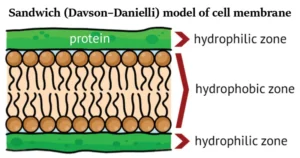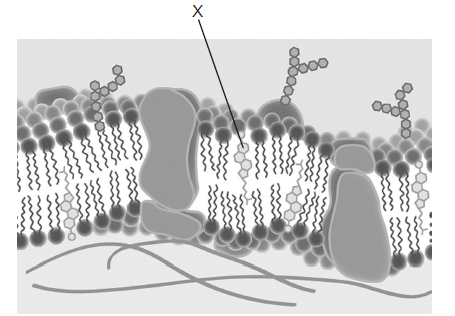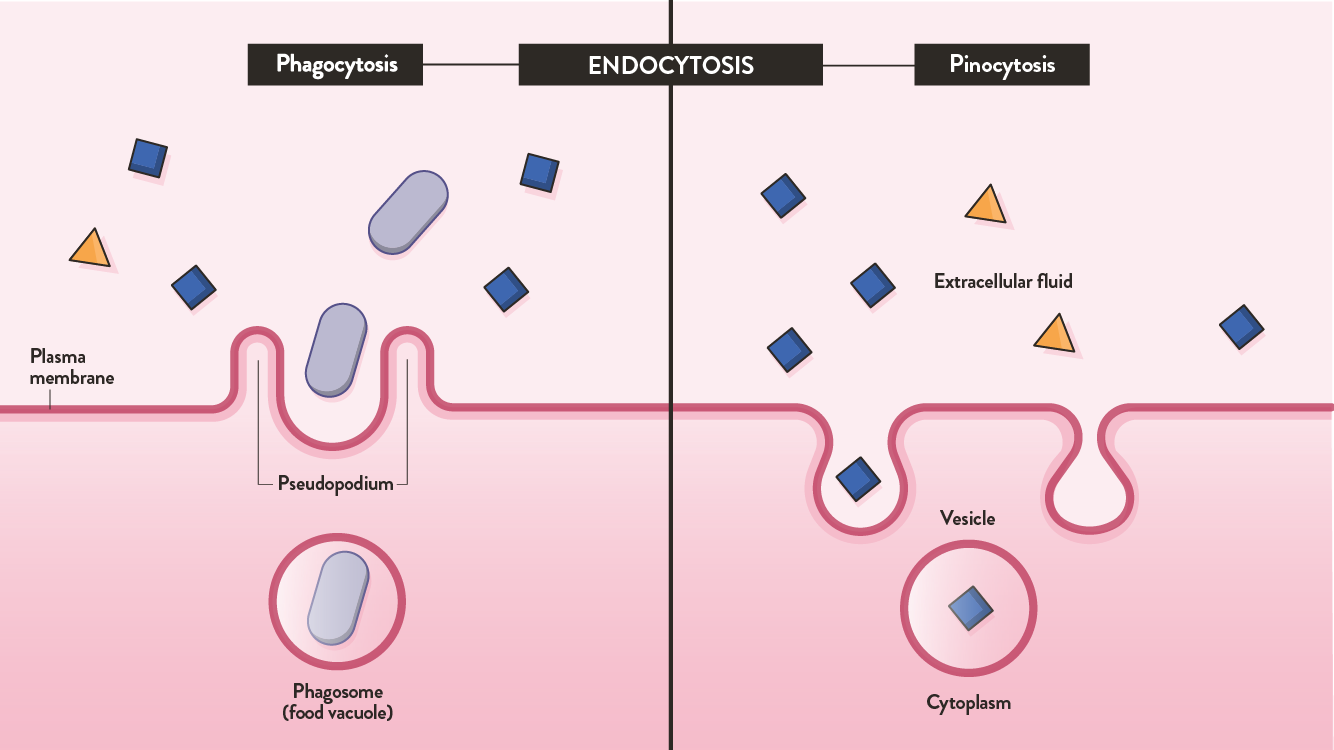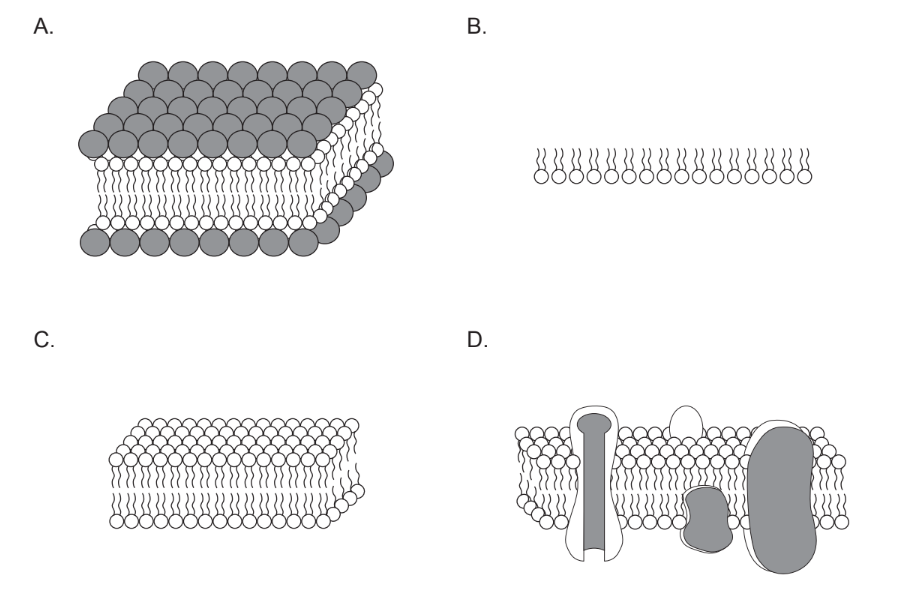IB Biology HL (HIGHER level)- 2024 – Practice Questions- All Topics
Topic 1.3 Membrane structure
Topic 1 Weightage : 8 %
All Questions for Topic 1.3 – Phospholipid Bilayer, Membrane Proteins , Cholesterol, Fluid-Mosaic Model, Membrane Models, Phospholipids, Membrane Fluidity, Extracellular Matrix
Question
Which statement applies to cholesterol?
It is hydrophobic and found on the outside of the phospholipid bilayer.
It is hydrophilic and found inside the phospholipid bilayer.
It impacts membrane fluidity.
It is transported in association with glucose in the blood.
▶️Answer/Explanation
Ans: C

Cholesterol is a type of lipid that is found in the cell membrane. It has a hydroxyl group that can attach to the phosphate head of the phospholipids, and a hydrocarbon tail that can interact with the fatty acid tails of the phospholipids. Cholesterol affects the membrane fluidity by changing the space and interaction between the phospholipids.
At high temperatures, cholesterol decreases fluidity by making the phospholipids pack more tightly and reducing their movement. This also makes the membrane less permeable to water-soluble substances.
At low temperatures, cholesterol increases fluidity by preventing the phospholipids from packing too closely and becoming rigid. This helps the membrane to maintain its flexibility and function.
Question
The Davson–Danielli model of membrane structure proposed that membranes were composed of a phospholipid bilayer that lies between two layers of globular proteins, as shown in this diagram.

What evidence supported this model?
An electron micrograph that showed two dark lines with a lighter band in between
Freeze-fracture electron microscopy
Evidence that all membranes are identical
The hydrophobic regions of protein would be in contact with water
▶️Answer/Explanation
Ans: A

The Davson-Danielli model was a model of the plasma membrane of a cell, proposed in 1935 by Hugh Davson and James Danielli. The model describes a phospholipid bilayer that lies between two layers of globular proteins. The model was supported by electron microscopy, which showed three distinct layers within a cell membrane, with an inner white core and two flanking dark layers. The model also explained the selective permeability of the membrane and its thinness.
However, the Davson-Danielli model was later falsified by several lines of evidence, such as:
– Membrane proteins were discovered to be insoluble in water and varied in size, which contradicted the idea of a uniform and continuous protein layer around the membrane.
– Membrane freeze-fracturing revealed irregular rough surfaces in the membrane, representing trans-membrane integral proteins that spanned the lipid bilayer.
– Fluorescent antibody tagging of membrane proteins demonstrated their fluidity within the membrane, which was inconsistent with the rigid protein layers in the Davson-Danielli model.
Therefore, the Davson-Danielli model is not supported by current evidence and has been replaced by the fluid mosaic model, which includes transmembrane proteins and accounts for the dynamic nature of the membrane.
The diagram shows a plasma membrane.

Which molecule is labelled X?
A. Cholesterol
B. Glycoprotein
C. Phospholipid
D. Amylase
▶️Answer/Explanation
A

Cholesterol is a type of lipid that is found in the cell membrane. It has a hydroxyl group that can attach to the phosphate head of the phospholipids, and a hydrocarbon tail that can interact with the fatty acid tails of the phospholipids. Cholesterol affects the membrane fluidity by changing the space and interaction between the phospholipids.
At high temperatures, cholesterol decreases fluidity by making the phospholipids pack more tightly and reducing their movement. This also makes the membrane less permeable to water-soluble substances.
At low temperatures, cholesterol increases fluidity by preventing the phospholipids from packing too closely and becoming rigid. This helps the membrane to maintain its flexibility and function.
Which are functions of membrane proteins?
A. Hormone binding sites and DNA replication
B. Cell adhesion and translation
C. Cell to cell communication and protein pumps
D. Passive transport and glycosis
▶️Answer/Explanation
C

Cell membrane proteins are protein molecules that are attached to, or associated with, the membrane of a cell or an organelle. They have a range of important functions, such as channeling or transporting molecules across the membrane, communicating with other cells, and catalyzing chemical reactions. There are three main types of membrane proteins: integral, peripheral, and lipid-anchored.
Integral membrane proteins are permanently embedded within the plasma membrane and can either span the entire membrane (transmembrane) or be attached to one side of the membrane (integral monotopic).
Peripheral membrane proteins are loosely bound to the surface of the membrane or to other membrane proteins by electrostatic or hydrogen bonds.
Lipid-anchored membrane proteins are covalently attached to a lipid molecule that is inserted into the membrane.
The working mechanism of membrane proteins depends on their specific function and structure. For example, some membrane proteins act as channels that allow certain ions or molecules to pass through the membrane by diffusion. These channels can be either open or gated by a stimulus, such as voltage, ligand, or mechanical force. Other membrane proteins act as carriers that bind to a specific substance and transport it across the membrane by changing their shape. Some carriers use energy from ATP hydrolysis to move substances against their concentration gradient, and these are called pumps. Another example of membrane proteins are receptors, which bind to specific molecules (such as hormones or neurotransmitters) and trigger a cellular response, such as activating a signal transduction pathway or opening an ion channel.
Which process is possible due to the fluidity of cell membranes?
A. Endocytosis
B. Osmosis
C. ATP production
D. Cell recognition
▶️Answer/Explanation
Markscheme
A

Endocytosis is a process of actively transporting molecules into the cell by engulfing it with its membrane. There are different types of endocytosis, such as caveolae, macropinocytosis, receptor-mediated endocytosis.,and phagocytosis. Endocytosis is a form of active transport and it involves components such as early endosomes, late endosomes, and lysosomes.
The phospholipids in the cell membrane are not solid but are in a fluid state allowing the membrane to change its shape and also vesicles to fuse with it. This means substances can enter the cell via endocytosis and exit the cell via exocytosis. The membrane then returns to its original state.
Question
In 1925, Gorter and Grendel carried out an experiment to study the structure of cell membranes in different mammals. The total surface area of red blood cells was measured in a sample and compared to the surface area formed by a single layer of lipid extracted from cell membranes and floated on water.

Which diagram best illustrates Gorter and Grendel’s conclusion drawn from this experiment?

▶️Answer/Explanation
Ans:C